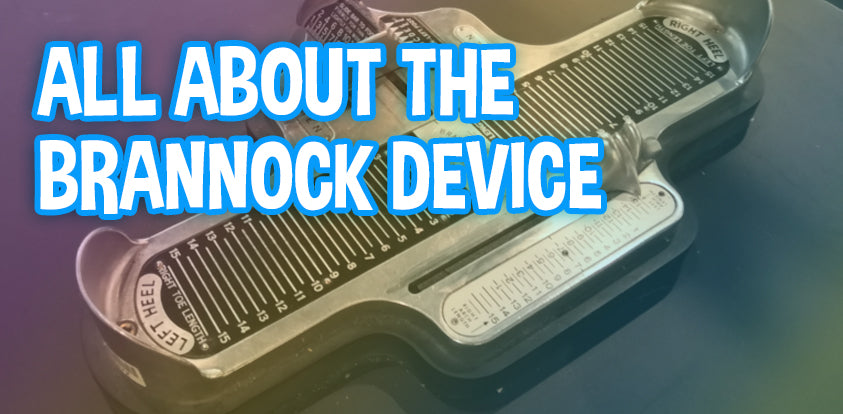
All About The Brannock Device
Share

It's been a long time since I needed to utilize a Brannock device. My growing days are long behind me, but I know it won't be long before I'm shoving my son's foot into one of these at least twice a year to ensure his shoes fit correctly. There are plenty of people that just call these a 'foot measurer', but the true and proper name is Brannock device.
Next time you're at the shoe store, you might choose to blow someone's mind by asking them to hand you the Brannock. Today we're going to go over all that you could possibly want to know about this unsung staple of modern living. Where did it come from and how to properly use it are at the forefront of this article's creation. So let's dive in.

History of the Brannock Device

The first version of the Brannock device was patented in 1925 by one Charles F. Brannock. Charles' father was an entrepreneur in the shoe industry so presumably this was his way of jumping into the family business with both feet, if you'll forgive the pun. An improved version of the device was patented in 1929 as a 'foot-measuring instrument'. An extremely apt name to say the very least.
Charles formed the Brannock Device company in Syracuse, New York to manufacture and sell his invention. Things went exceedingly well as you might have guessed. Brannock devices quickly became the industry standard, and some of the earlier models are housed at the Smithsonian. Charles headed the company until passing away in 1993 at the age of 89.
It was at this point that one Salvatore Leonardi purchased the company from the estate and moved manufacturing of Brannock devices to a small factory in Liverpool, New York. The people of Syracuse still celebrate this life-changing invention, and the minor league Syracuse Chiefs celebrated the Brannock device with a promotion on May 31st, 2018.

Instructions for Use
When I was a wee child my mom would drag me to Payless (we were broke) and I'd marvel at the arcane contraption that would measure my feet. How did it work? Aside from shoving my foot in it and having a salesperson fiddle with a couple of sliders, I truly had no idea. The mystery ends today. Brannock devices take three different measurements determining foot length, width, and perhaps most importantly the arch of your feet. If you ever need to operate one for yourself, here's how it is done:
But first, I'd like to mention that nobody likes stinky feet. Ensure that foot odor isn't distracting from a proper reading by preparing with a quick spray of fast-acting shoe deodorizer spray and/or long-lasting shoe deodorizer powder.

Prepare the Brannock Device
Set all the sliders to their widest possible position. For the arch length slider, you'll want to set it in position closest to the heel of whichever foot you are currently measuring. Which heel is quite clearly labeled on every model unless it has seen considerable wear and tear. If you can't find the markings for left and right, just keep in mind that the width bar goes on the outside of your foot, and the arch length slider stays on the inside curve.
Position the Foot
Remove shoes and socks. Place the back of your heel against the heel cup and distribute your weight evenly on both feet. I've seen quite a few people sitting while taking their foot measurement, but that will give an inaccurate result and lead to your new shoes squeezing your feet. You want your feet to be elongated and spread to the maximum size, as they would be if you were using them.
Heel-To-Toe Length
Press your toes flat and look straight down over the longest toe to get an accurate reading of foot length. Keep in mind that the first toe isn't always necessarily the longest one. Getting an accurate length is important as it will determine where the arch of the shoe ends up. Wearing shoes with misplaced arches for long periods of time can lead to serious medical problems, so don't hesitate to double or even triple check that your reading is spot on.

Measuring Foot Width
With the heel still firmly set against the heel cup, slide the width bar snugly against the outside edge of your foot. Locate the foot length and look below that to compare it quickly and easily to the width via the handy display provided on every Brannock device. If the shoe size falls between widths then you can use your own discretion. Wider shoes for thicker feet, narrower width for thin feet.
Arch Length Measurement
As stated this is absolutely imperative to get correct, lest you end up with back problems or requiring surgery. Luckily, the execution is quite easy. Drape your thumb over the top of your foot at the ball joint. The ball joint is below your toes, where the top of your foot begins to arch. Slide the pointer forward so the inside curve fits into the ball joint and the top of the sliding pointer is touching your thumb. Once the arch length slider is in position, all you need to do it make a note of which number it is pointing at.
Do It Again!
Repeat this process for the other foot. An experienced hand can knock this process out in just a few seconds, but it might take you a few minutes your first time through. As long as nobody is waiting for the Brannock device, take your time and get it done right for a proper reading. It seems like a crazy thing to say, but your health really does depend on well-fitting shoes. Fitting shoes isn't something to be taken lightly. Shoes can be tight and still fit well, but realize that they will never actually stretch. Since that's the case, consider snagging a set of our colorful metal shoehorns.
Clean and sanitize when you're done taking your measurements and have fun!
